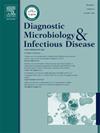在印度太平洋地区建立COVID-19抗原检测的质量保证:一项多地点实施研究
IF 2.1
4区 医学
Q3 INFECTIOUS DISEASES
Diagnostic microbiology and infectious disease
Pub Date : 2024-12-30
DOI:10.1016/j.diagmicrobio.2024.116677
引用次数: 0
摘要
背景:质量保证程序(qap)用于评估诊断测试的分析质量,并提供反馈以改进测试的质量过程。快速诊断测试在实验室和非实验室环境中都用于诊断COVID-19,尽管报告的性能有所不同。我们的目标是在柬埔寨、老挝人民民主共和国和巴布亚新几内亚设计并实施COVID-19抗原快速诊断检测(Ag-RDTs) QAP。方法:根据提供的培训和协议,使用来自Wildtype、Delta和Omicron分离株细胞培养的灭活SARS-CoV-2材料制造435个质量控制(QC)面板(由单个阳性和阴性样本组成)和36个外部质量评估(EQA)面板,用于15个站点。结果:两国共以电子报告或纸质形式提交了369份QC结果和112份EQA结果。质量控制中阳性和阴性检出率分别为19.3%(34/176)和99.5% (192/193),EQA中阳性和阴性检出率分别为37.5%(30/80)和97.5%(39/40)。结论:该QAP证明了操作人员培训和QAP材料设计的重要性,这可能是导致已知COVID-19阳性样本中假阴性解释率高的原因。据我们所知,该项目是该地区首个此类项目,也是全球为数不多的项目之一,其实施强调了质量保证原则的重要性,包括非实验室社区检测点,以提高COVID-19检测的诊断质量。本文章由计算机程序翻译,如有差异,请以英文原文为准。
Establishing quality assurance for COVID-19 antigen tests in the Indo Pacific Region: A multi-site implementation study
Background
Quality assurance programs (QAPs) are used to evaluate the analytical quality of a diagnostic test and provide feedback to improve quality processes in testing. Rapid diagnostic tests were used in both laboratory and non-laboratory settings to diagnose COVID-19, although varied in reported performance. We aimed to design and implement a QAP for antigen rapid diagnostic tests (Ag-RDTs) for COVID-19 in Cambodia, Lao PDR, and Papua New Guinea.
Methods
Inactivated SARS-CoV-2 material derived from cell culture of Wildtype, Delta, and Omicron isolates were used to manufacture 435 quality control (QC) panels (consisting of a single positive and negative sample) and 36 external quality assessment (EQA) panels for use across 15 sites in accordance with provided training and protocols.
Results
In total, 369 QC results and 112 EQA results were submitted by electronic reporting or paper forms by two countries. 19·3 % (34/176) positive and 99·5 % (192/193) negative samples were correctly reported in the QC, and 37·5 % (30/80) positive and 97·5 % (39/40) negative samples were correctly reported in the EQA.
Conclusion
This QAP demonstrates the importance of operator training and the design of QAP materials, which may have contributed to the high rate of false-negative interpretations in known COVID-19 positive samples. The implementation of this project, to our knowledge the first of its kind in the region and one of only a few globally, emphasised the importance of quality assurance principles, including non-laboratory community testing sites, to promote diagnostic quality for COVID-19 testing.
求助全文
通过发布文献求助,成功后即可免费获取论文全文。
去求助
来源期刊
CiteScore
5.30
自引率
3.40%
发文量
149
审稿时长
56 days
期刊介绍:
Diagnostic Microbiology and Infectious Disease keeps you informed of the latest developments in clinical microbiology and the diagnosis and treatment of infectious diseases. Packed with rigorously peer-reviewed articles and studies in bacteriology, immunology, immunoserology, infectious diseases, mycology, parasitology, and virology, the journal examines new procedures, unusual cases, controversial issues, and important new literature. Diagnostic Microbiology and Infectious Disease distinguished independent editorial board, consisting of experts from many medical specialties, ensures you extensive and authoritative coverage.

 求助内容:
求助内容: 应助结果提醒方式:
应助结果提醒方式:


